I’m Usman, and I’m a cube writer who’s been writing about cube for over a decade. This is the first of many articles here that I’ll be writing about cube at Hipsters at the Coast.
To begin, I’ll touch upon Toxic and poison. They’re less parasitic than infect since the creatures deal poison in addition to regular damage, but it’s mostly useless from 0-9 poison damage so, for the most part, Toxic is more flavor text than win condition. Therefore, the cards with Corrupted are misses for a cube metagame, unless you’re including multiples and/or heavily skewing your cube metagame to include poison as a role-player.
I’ve sorted the cards by approximate interest, but it isn’t a definitive ranking.
White
Skrelv, Defector Mite
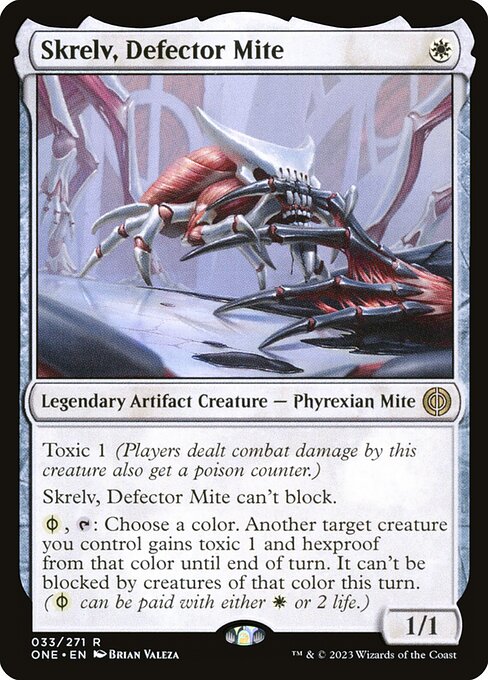
Skrelv, Defector Mite asks how many downsides can a Mother of Runes variant have before it catches up to her. Skrelv is worse than previous versions since it can’t block, the tap ability requires mana/life to activate, only gives hexproof from colors (not full protection) and, like Giver of Runes, can only protect other creatures. Since Skrelv can’t block either, this card is mainly suited for aggressive decks.
Being able to use Phyrexian keeps the aggressive player from playing off-curve – A huge liability for white aggressive creatures of yore. However, the life payment can add up over the course of the game, especially in the aggro and midrange matchups. The ability does have “threat of activation,” meaning there will be many times where she will protect a creature without you having to spend resources doing so, but like with Adanto Vanguard, be careful not to overuse your life as a resource.
Despite the downsides, Skrelv still does a lot of what I liked from the other Runes creatures – it scales up incredibly well into the late game by helping attackers slip by boards with singular creatures to alpha strike, provides protection for marquee threats and is a body that can attack, if need be. Will Skrelv see long-term play in my cube? It just mite.
Planar Disruption & Ossification
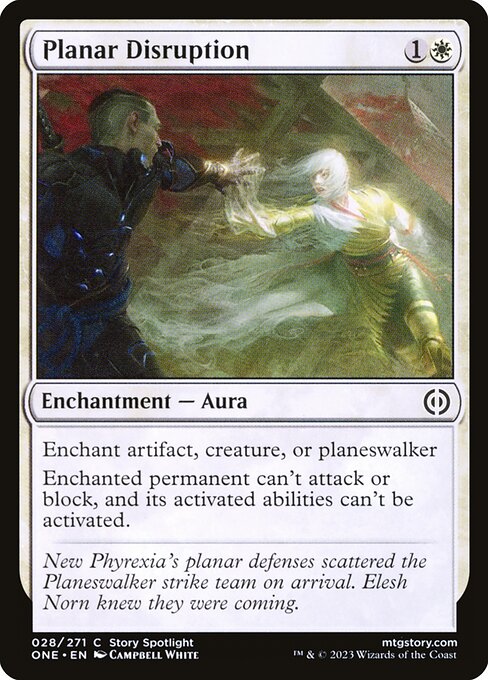
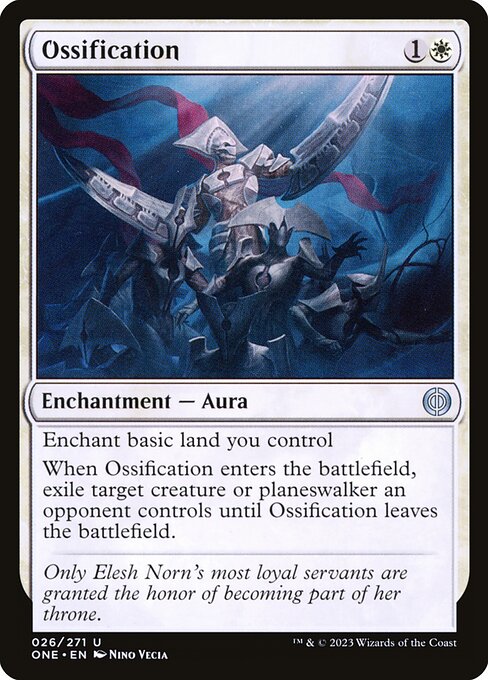
Both Planar Disruption and Ossification are strong 2-mana options to remove a troublesome creature or planeswalker at sorcery speed. Planar Disruption is the better of the two, since it also shuts down artifacts, isn’t reliant on basic lands and arguably is better if destroyed (since destroying an Ossificationed creature can reset ETB triggers and loyalty on planeswalkers) but they’re close enough in raw power level and function where a cube that wants one will want both. Cheap catch-all removal for white aggro decks is always ossome to have.
Staff of the Storyteller

An /r/mtgcube thread made me realize this as a pseudo Thraben Inspector, since both can make a body and draw for 3 mana. Staff gets better when you’re able to reliably generate tokens, but it’s arguably worse as a standalone card since the base rate of a 2 mana Suntail Hawk is worse than Inspector’s 1-mana squire. Still, nice in cubes that are looking for a token generation payoff.
Elesh Norn, Mother of Machines
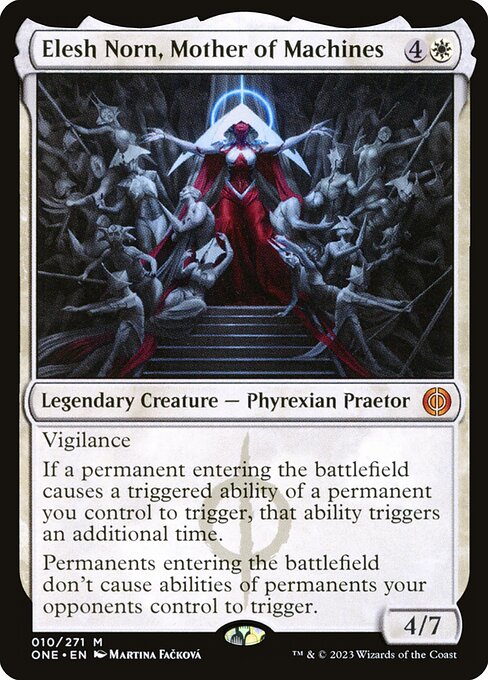
As a Panharmonicon + Torpor Orb, Elesh Norn, Mother of Machine’s reliant on being alive to either boost or neuter creatures, true to Elesh Norn form. Since she doesn’t do anything on her own, her shelf life in a cube is reliant on the speed and cost of the removal that can kill her versus the size of her 4/7 vigilant body and the probability that she’ll be able to get her mana’s worth by being able to effectively double/neuter ETB triggers. My initial instinct is that it isn’t enough.
Blue
Experimental Augury
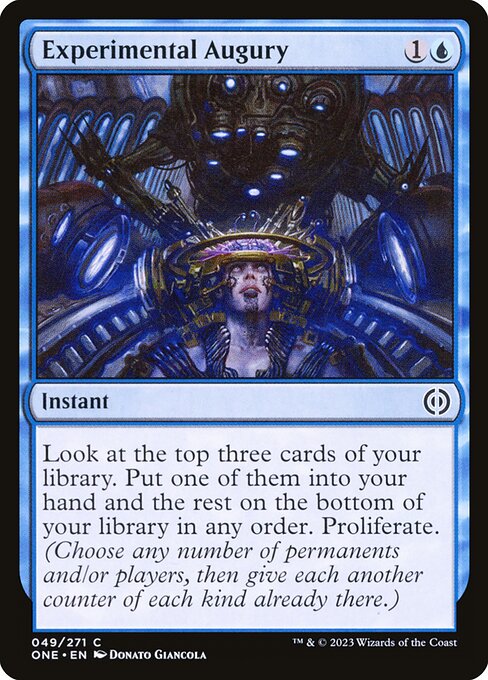
Historically, cards with Proliferate have had a hard time making it into cube, with Contagion Clasp and Karn’s Bastion being too mana-inefficient. The best Proliferator was Sword of Truth and Justice, having a fine floor of giving a creature a permanent +2/+2 buff, but never quite seeing the adoption rates that its Fire & Ice or Feast & Famine brethren did.
In addition to it working well with decks that focus on/incidentally have a lot of cards that have counters to proliferate, Experimental Augury just naturally plays to strengths of Planeswalker-heavy control decks as something to do while holding up at instant speed and doing something at a decent enough rate, which is usually a good sign for a cube card.
This deck from Jbro’s twitter is a good example of a deck that would be able to use Experimental Augury effectively, which the trophy deity himself noted that he’d play over Mulldrifter in that deck and over Frantic Search in this deck.
Mercurial Spelldancer
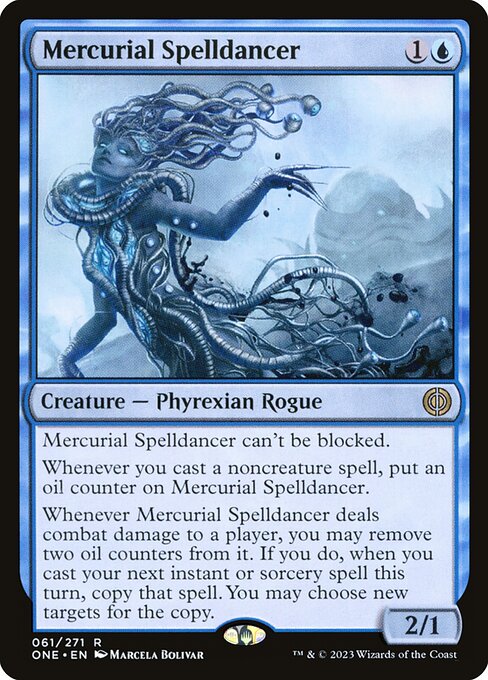
Effects that require a spell at the ready tend to play worse than they look, and requiring 2 oil counters while having to survive to connect can mess with the consistency of being able to copy a spell, but when looked at as an evasive beater first and spell xeroxer second, Mercurial Spelldancer looks pretty good.
Jace, the Perfected Mind
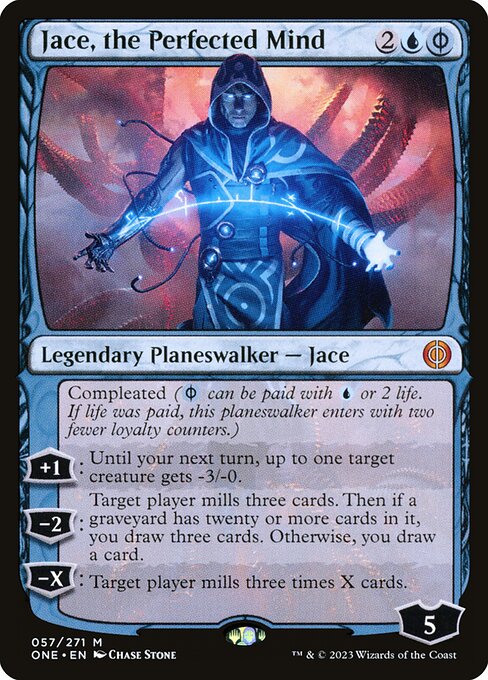
Cards like Sphinx’s and Teferi’s Tutelage put a clock on the opponent, but ultimately do very little if the opponent does not mill out. Jace, the Perfected Mind ticks up while protecting himself, building loyalty until the -X can finish the opponent off. Even late, paying full retail price and immediately milling for 15 can be a win con by itself. The minus ability isn’t useless either, since naturally playing long games can result in graveyards that are close to 20. Flexible casting, protection on uptick, flexible ultimate: this guy is the compleat package.
Black
Sheoldred’s Edict

Sheoldred’s Edict is a premium removal spell that emulates Hero’s Downfall more than the standard Edict effect. The planeswalker edict mode is notable since often, there’s only one opposing planeswalker out, helping its consistency. Its non-token option helps to get around one of the annoying things about Edicts – being bad against tokens, but having the option to kill a token is nice, if need be; often, it’s hitting something good.
Annihilating Gaze
Annihilating Gaze is this set’s Eaten Alive riff as an efficient removal spell that can be cast for 5. Unlike with Eaten Alive, you can sacrifice artifacts, although how often that occurs depends on your cube meta. Still, I think it’s enough of an upside to be not just flavor text.
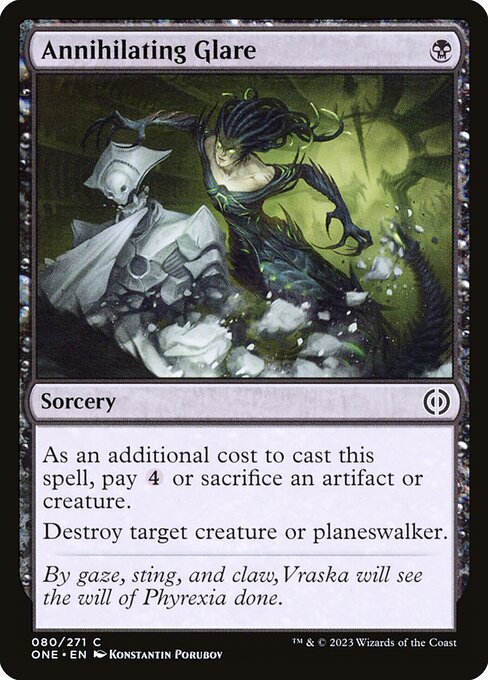
Drown in Ichor
Drown in Ichor is somewhat relying on Proliferate to do some lifting to make up for it being a sorcery-speed kill spell in a color bevy with Doom Blades, but the base rate of killing a small-to-midsize creature at sorcery speed and proliferating is still a good deal for 1B in most cube metas. In decks that have a critical mass of things to proliferate, this may even be better – killing a creature and upticking a Tangle Wire/Umezawa’s Jitte should be GG.
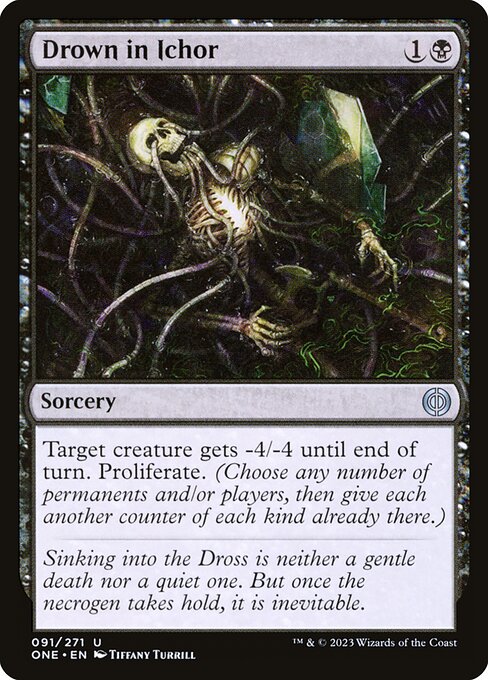
Black Sun’s Twilight

Black Sun’s Twilight is nice as scalable removal, although it’s never an efficient one. Although the creature enters tapped, getting a creature back at instant speed is great for turning tides quickly. Best in decks with small creatures and attrition battles, but fine in midrange too as a Betrayal of Flesh to bring back bigger things, if necessary.
Red
Koth, Fire of Resistance
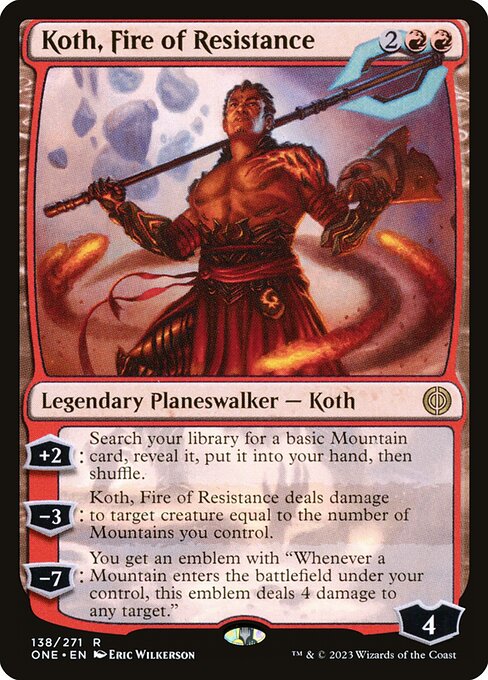
Koth, Fire of Resistance is essentially a Liliana of the Dark Realms that can survive after killing something. This card has some other knobs tweaked too; additional loyalty on + in exchange for only getting basics and some higher loyalty. Like old Koth, this can emblem quickly, but this Koth is more suited more for “big red” decks by accruing value rather than ending the game ASAP. Once you ultimate, any mountain (not just basics) will trigger it, and 4 damage a pop will organically end the game in your favor.
Exuberant Fuseling
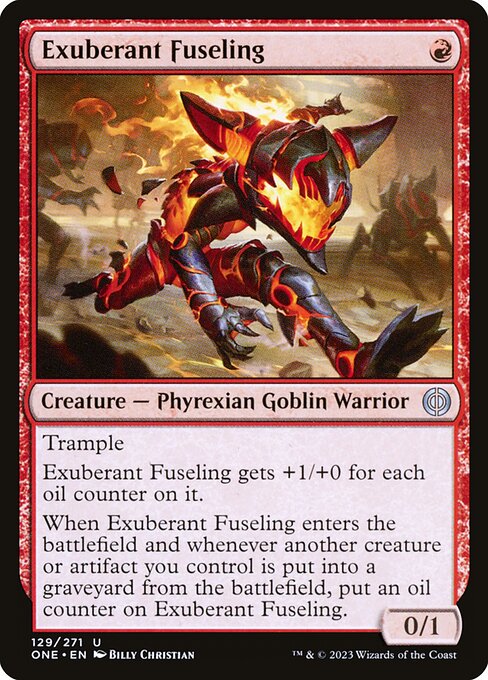
Exuberant Fuseling starts as a 1/1 but it’s an easier-to-grow Experiment One that dies to a stiff wind. However, this at least fits most red decks more naturally than Experiment One does to most green decks. It doesn’t take long for it to be a 2/1, let alone a 3/1, which aligns well with red aggro’s game plan.
Capricious Hellraiser

Capricious Hellraiser is a large Mulldrifter that I’m cautiously optimistic about since it represents a lot of value for the mana, even if you get a Lightning Strike. It’s odd because fetchlands help to get to 9 cards, but it’s awful if you get 3 lands with its ETB trigger; but the odds are pretty small. Still, it’s a 6-mana card as a floor, which makes me hesitant.
Green
Cankerbloom
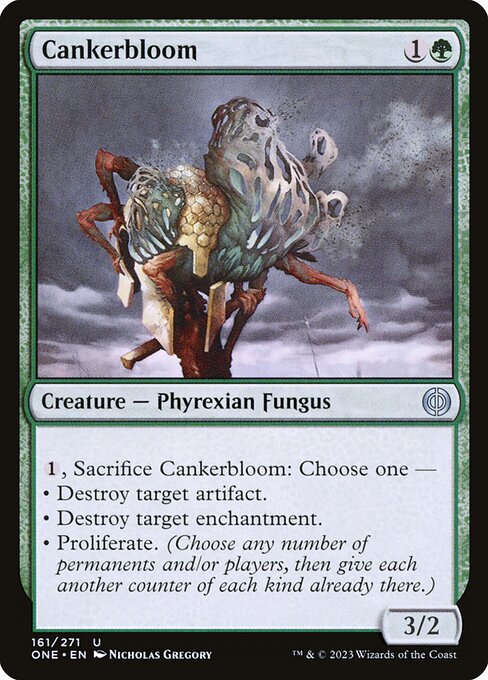
Cankerbloom is an Outland Liberator with a better clock, which is helpful to provide impact to a card if there are no artifacts or enchantments out. Getting Proliferate for free on top of the Naturalize mode is nice as an option if you have targets out, and as a “threat of activation” that the opponent will have to respect if a walker is close to ultimate range – and although it looks marginal, giving a proactive mode on a card whose modes are mostly reactive makes it useful in more game states.
Thrun, Breaker of Silence
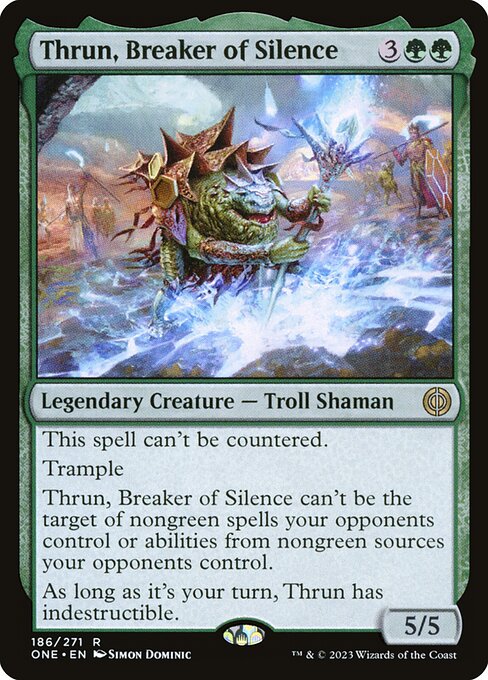
Thrun, Breaker of Silence is hard to kill, since he shrugs off most spot removal and, at least on your turn, can’t die. This lines up with the “Racing Green” school for green strategies, which helps green midrange not fall prey to cheap removal. All that said, green 5’s is a spot usually reserved for army in a can creatures (squirrel hermits) or walkers such as Garruk, Vivien, or The Nissas. Speaking of…
Nissa, Ascended Animist
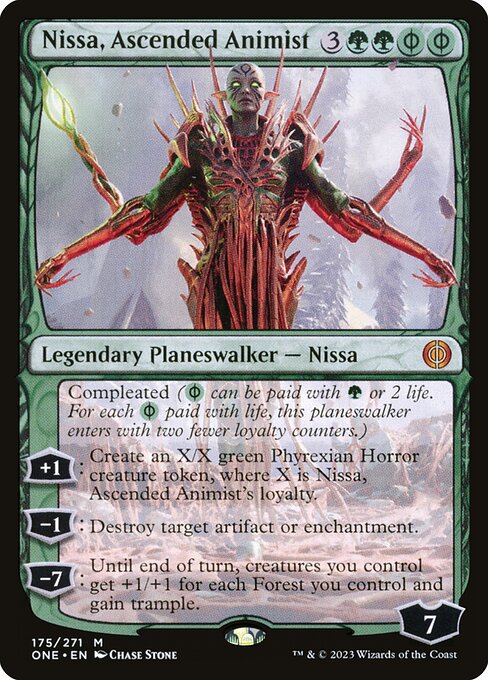
Nissa, Ascended Animist fits a similar mold as a virtual 5-mana card that makes a 4/4 and makes additional larger ones as the game goes on. Nissa also evokes Freyalise, Llanowar’s Fury as a repeatable Naturalize, which can be useful in some cube metas. It’s worse than Nissa, Who Shakes the World, the queen of 5-mana green walkers, but she’s solid as a mid-sized threat with lasting impact. She can be cast for more mana if you have fallow mana lying around, and can even be a very expensive Overrun to end the game. That said, she’s one of the better base rates sizewise for the tokens, is a scaleable threat, and comes with some utility.
Conduit of Worlds

Like previous Crucible effects, Conduit of Worlds relies on being in play for several turns. This takes fewer turns to get your mana’s worth, provided that you can cast a spell from the graveyard a turn, which is mostly reliant on whether your deck can churn through permanents and/or how well your deck can utilize that, via mass removal/sacrificing permanents.
Other
Sword of Forge and Frontier
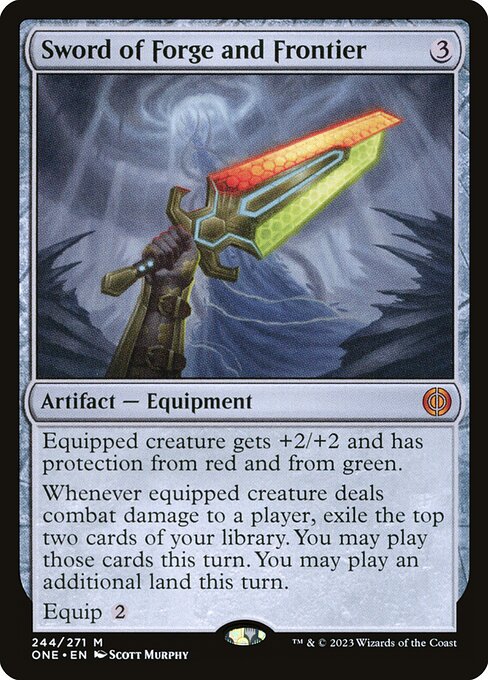
One of the better swords, Sword of Forge and Frontier is arguably the best sword in decks that can reliably “draw 2” via cheap spells. Being able to explore isn’t useless, since it can help you snowball card advantage from the sword trigger as well. Its protections are on the weak side, but the raw card advantage more than makes up for it.
Kaito, Dancing Shadow
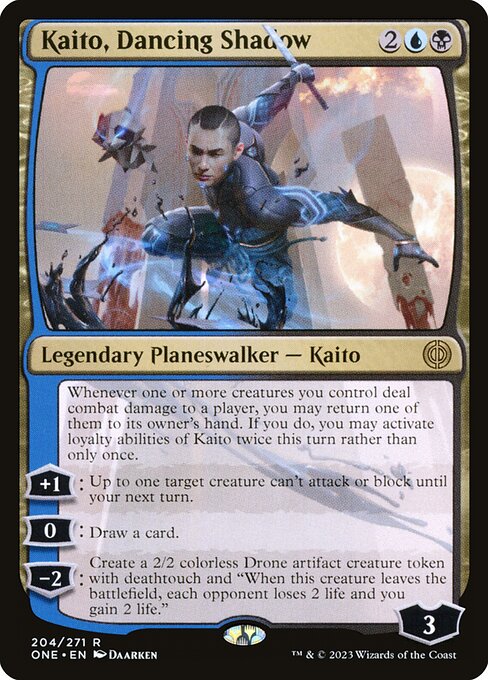
Kaito, Dancing Shadow rewards playing the tempo game, but is still good in more passive shells, with his uptick neutralizing the biggest threat, his middle ability drawing cards, his -2 creating a token to block, and his static even helping by letting you cash in the drone or a value creature for another activation. In cubes with a lot of mana fixing, he’s even a good splash in tempo decks that share a color, especially in colors ripe with ETB triggering creatures.
Atraxa, Grand Unifier
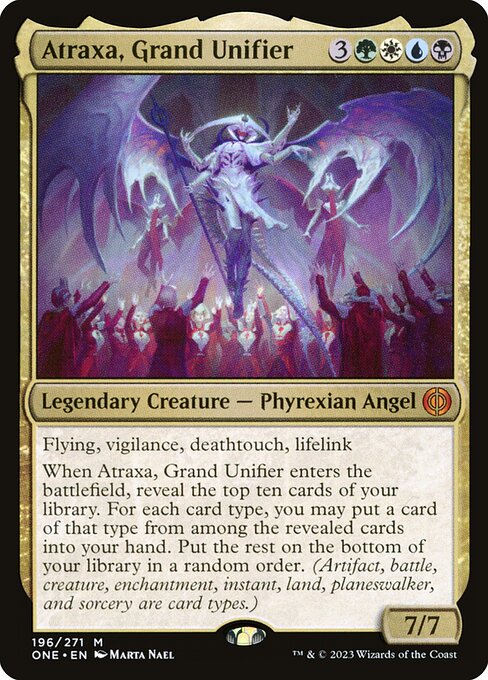
Atraxa, Grand Unifier is a giant Mulldrifter, usually getting several cards without needing to draft heavily around it (ala Niv-Mizzet Reborn) with sizable impact if it lives. Do not let the 4 color cost fool you, as you can put her into play with one of the many cheat spells. Or just hit the colors as you ramp to 7.
I’ve talked about more of the cards from the set on my blog, so if you’re wondering why I didn’t talk about a card here, it’ll be there (to be completed later today.)
Shoutouts to Zolthux for the article assistance and being an awesome and funny dude. 🙂
Links to my blog, previous articles and podcast!
Usman Jamil (he/him) has been creating Cube content since 2009 and created the first and longest running Cube podcast, The Third Power. He is a member of the Pauper Cube Committee and created the Ravnica Cube on Magic Online. His linktree is: https://linktr.ee/Usmantherad

